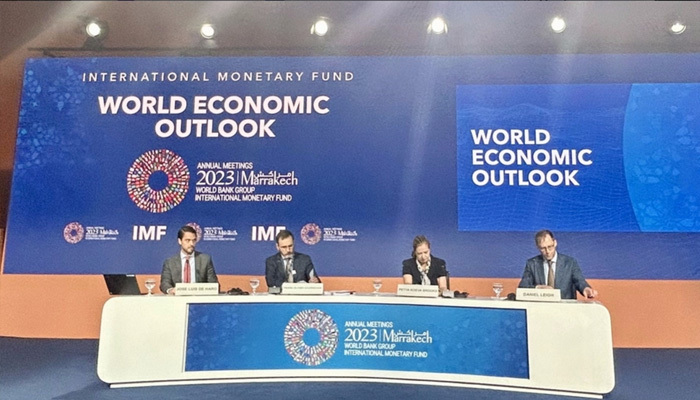In a recent report by the International Monetary Fund (IMF), Pakistan’s economic performance for the last fiscal year exceeded expectations, paving the way for a more positive outlook in the current and next fiscal years despite prevailing macroeconomic challenges.
The IMF’s World Economic Outlook for October, released on a Tuesday, projects a notable growth trajectory for Pakistan. Anticipating a growth rate of 2.5% in the country’s economy for the ongoing fiscal year, this figure is expected to double to 5% in the following fiscal year. These estimates mark a significant recovery from the 0.5% contraction witnessed in the preceding fiscal year.
This promising outlook suggests that Pakistan’s economic recovery is gaining momentum, showing resilience and potential for a robust future despite the lingering macroeconomic challenges. The IMF’s projection of a 5% GDP growth rate for the 2026-27 fiscal year further underscores the positive trajectory Pakistan is aiming for.
The IMF’s revised growth forecast appears to be influenced by the most recent and up-to-date data, tracked daily, weekly, fortnightly, and monthly across various sectors. This revision led to a more optimistic outlook compared to earlier projections, now foreseeing a 5% GDP growth rate in the 2026-27 fiscal year. These revisions demonstrate the IMF’s confidence in Pakistan’s potential to recover and grow its economy.
However, the IMF’s growth forecast is slightly lower than the government’s target of 3.5% GDP growth for the current year. Nevertheless, it significantly surpasses the projections put forth by other multilateral agencies such as the World Bank and the Asian Development Bank (ADB). This variance in projections highlights the complexity of economic forecasting and the importance of analyzing various aspects of the economy.

The World Bank’s estimates for Pakistan’s growth rate were considerably more conservative at 1.7% for this fiscal year and 2.4% in the next. In contrast, the ADB projected a growth rate of 1.9% for the current fiscal year. These differing forecasts reflect the diverse methodologies and considerations used by different organizations while predicting economic growth.
The IMF also revised its inflation and unemployment rate projections upwards for both the current and next fiscal years. It estimated a higher inflation rate of 29.2% for fiscal 2023, up from its earlier projection of 27%. This upward revision acknowledges the challenges posed by inflation and the need for realistic estimations to navigate these economic hurdles.
Additionally, unemployment rates were expected to rise to 8.5% in fiscal 2023 from 6.2% in the previous year. This upward shift in unemployment rates emphasizes the need for targeted strategies to enhance employment opportunities and stimulate economic growth.
On a global scale, the IMF maintained its forecast for 2023 but cautioned about the high inflation rates impacting various economies, particularly China and Germany, whose outlooks were downgraded. The global economy, while recovering, remains challenged by inflation and geopolitical events.
The Middle East and Central Asia are also experiencing a varied economic outlook, influenced by factors like the Gaza conflict and oil-rich economies like Saudi Arabia. Despite challenges, the IMF’s outlook underscores the resilience and adaptability of economies in the face of evolving geopolitical dynamics and economic fluctuations.
The German economy, Europe’s largest economy, is expected to shrink by 0.5% this year. This contraction highlights the need for strategic economic measures to stimulate growth and stability within the region.
The IMF’s updated outlook emphasizes resilience in the face of challenges, showcasing the evolving dynamics of the global and regional economies. The ability to adapt to changing circumstances and implement effective economic strategies remains crucial for sustaining growth and ensuring stability.
In conclusion, Pakistan’s economic outlook, as projected by the IMF, reflects a positive trajectory with expectations of significant growth in the coming fiscal years. These projections provide valuable insights for policymakers and stakeholders to tailor strategies that capitalize on this potential growth and navigate the economic landscape effectively. Maintaining this momentum and addressing challenges will be key to realizing the projected growth and fostering a stable and prosperous economic future for Pakistan.





